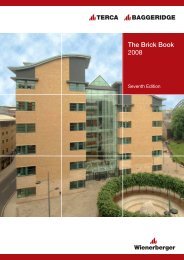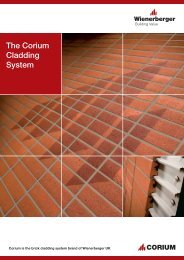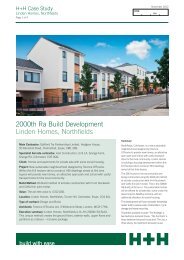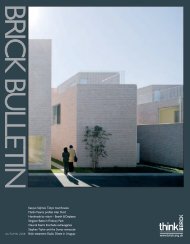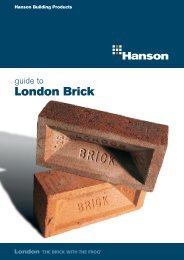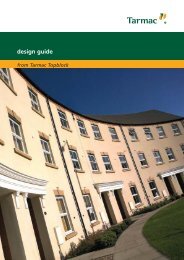Chailey - Ibstock
Chailey - Ibstock
Chailey - Ibstock
You also want an ePaper? Increase the reach of your titles
YUMPU automatically turns print PDFs into web optimized ePapers that Google loves.
Wall to wall innovation no:<br />
230<br />
SPRING 2011<br />
Elementix ® is an innovative range<br />
of clay rainscreen cladding systems<br />
developed to offer an unrivalled<br />
choice in façade finishes.<br />
Elementix ® Express is a cost<br />
effective and quick to build system<br />
in a range of the most popular size<br />
formats, natural clay colours and<br />
surface finishes.<br />
Elementix ® Colour offers a virtually<br />
unlimited palette of ceramic glazed<br />
finishes to make every project unique.<br />
Elementix ® Freedom<br />
removes the design<br />
constraints of standard<br />
panel formats allowing<br />
sizes to be specified<br />
to suit the building. In<br />
addition Elementix ®<br />
Freedom has exceptional<br />
sustainability credentials.<br />
see how easy it is to install<br />
<strong>Chailey</strong> - Celebrating 300<br />
years of production<br />
scan our QR code<br />
with your smartphone<br />
For more information visit www.ibstock.com<br />
Sussex clay be good and strong<br />
to serve ‘ee long and well<br />
Be it bricks, pots or pipes<br />
or strong tankards for good ale<br />
Traditional Sussex Verse
News from the Editor<br />
Spring 2011<br />
IBSTOCK DZINE MAGAZINE<br />
Published by:<br />
<strong>Ibstock</strong> Brick Ltd, <strong>Ibstock</strong>, Leicestershire, LE67 6HS<br />
Editor: Anne Grose<br />
Tel: 01530 261999 Email: marketing@ibstock.co.uk<br />
Front Cover: Blue Boulevard, The Quay,<br />
Hasselt, Belgium<br />
Environmental Report 2010<br />
For many years <strong>Ibstock</strong> has been producing<br />
an Environmental Report on its business.<br />
This warts and all overview for last year<br />
is now available to download from the<br />
<strong>Ibstock</strong> website - www.ibstock.com -<br />
but the following is a summary of what<br />
is currently being carried out.<br />
People<br />
<strong>Ibstock</strong> recognises that to ensure the future<br />
success of the Company it must be committed<br />
to the communities in which it operates.<br />
It supports local rural communities where it is<br />
probably the single largest employer in some areas<br />
of the country. Some 58% of <strong>Ibstock</strong>’s employees<br />
have more than 10 years’ service.<br />
The <strong>Ibstock</strong> Cory Environmental Trust is supported<br />
financially, and it distributes £450,000 pa to<br />
deserving community projects under the Landfill<br />
Tax Credit Scheme. Highlights include:<br />
• The refurbishment of a community swimming<br />
pool in the ground of Gigs Mill Primary School.<br />
The funding of this valuable community facility<br />
means that the swimming pool is available for<br />
use by the school and local community all year<br />
round as opposed to the previous six weeks<br />
a year.<br />
• The trust has given a grant to the Wildfowl and<br />
Wetland Trust which has enabled biodiversity<br />
works to be undertaken at Martin Mere Nature<br />
Reserve as part of the reserve’s Canoe Safari.<br />
• In Sevenoaks, the Trust purchased a piece of land<br />
which will enable the 4th Sevenoaks (St John’s)<br />
Scouts to continue their scouting pursuits.<br />
Did you know that the embodied<br />
energy in facing brick is 8.2MJ/kg<br />
which is less than general timber<br />
at 8.6MJ/kg<br />
Despite facing a financially difficult few years<br />
the Company has remained committed to<br />
the development of its employees and a new<br />
environmental awareness training package has<br />
been developed and presented to all employees in<br />
addition to offering The Institute of Environmental<br />
Contents<br />
Management and Assessment Foundation Training<br />
Course to senior managers.<br />
All of <strong>Ibstock</strong>’s suppliers are encouraged to follow<br />
in its footsteps and achieve ISO 9001 on Quality<br />
Management and ISO 4001 on Environmental<br />
Management or BES 6001 approval for responsible<br />
sourcing. Preference is given to suppliers who have<br />
achieved these ratings.<br />
Did you know that using <strong>Ibstock</strong><br />
bricks gains more points when<br />
assessed by the Code for Sustainable<br />
Homes as all <strong>Ibstock</strong> factories have<br />
achieved ‘Very Good’ in accordance<br />
with BES 6001 Responsible Sourcing<br />
of Construction Products<br />
The Environment<br />
When you choose a product from <strong>Ibstock</strong> you<br />
can be sure that you are sourcing responsibly.<br />
The Company believes in monitoring the<br />
impact that it has on the environment and<br />
it continually tries to reduce its wastage and<br />
energy consumption and improve its recycling<br />
and water re-use.<br />
All 20 of the factories hold BS EN 14001 for<br />
Environmental Management and <strong>Ibstock</strong> was the<br />
first brick manufacturer to achieve a ‘Very Good’<br />
rating in BES 6001 for responsible sourcing.<br />
The Company has a dedicated Environmental<br />
Continuous Improvement Working Group who<br />
meet throughout the year to discuss how the<br />
company can be more responsible and to ensure<br />
that progress is being made. During 2010 it was<br />
a major contributor on a Carbon Footprint for the<br />
UK brick industry which was third part accredited<br />
to PAS 2050.<br />
With 20 factories situated throughout the<br />
UK, <strong>Ibstock</strong> is quite literally your local<br />
supplier. On average the bricks<br />
only travel 80 miles from where<br />
they are manufactured to<br />
where they are used, reducing<br />
traffic congestion and vehicle<br />
emissions.<br />
Every year it recovers and sends<br />
for recycling approximately<br />
News 2<br />
The History of <strong>Chailey</strong> 4<br />
<strong>Chailey</strong> through the Ages 8<br />
Two Houses, Killiney, Dublin 10<br />
Blue Boulevard, The Quay, Hasselt, Belgium 12<br />
Belgravia Place, Graham Terrace, London, SW1 14<br />
Hertford Regional College, Ware, Hertfordshire 16<br />
Inspirations 18-21<br />
Back to Basics, Clamp Firing 22<br />
50,000 litres of spent lubricating oils, 1,300 tonnes<br />
of scrap metals and 150 tonnes of wood from<br />
scrap pallets.<br />
The Company has numerous biodiversity projects<br />
on the go including;<br />
• Four biodiversity surveys to investigate<br />
the presence of bats.<br />
• One biodiversity project to investigate<br />
the presence of badgers.<br />
All waste up to the kiln firing stage is recycled.<br />
Once the firing process has taken place the<br />
inert fired brick hard core is either used for the<br />
Company’s own purposes as an alternative to<br />
primary aggregate for building quarry access<br />
roads or it is sold for use as secondary aggregate.<br />
Approximately 45 thousand tonnes of primary<br />
aggregate is saved each year by using these<br />
non-saleable items.<br />
Did you know that the average distance<br />
travelled by <strong>Ibstock</strong> bricks is 80 road<br />
miles The average distance for timber<br />
from Canada is 3000+ miles and from<br />
Scandinavia 1000+ miles.<br />
The manufacturing process of the bricks includes<br />
using secondary or waste materials from other<br />
industries. This reduces the quantity of primary<br />
aggregate that <strong>Ibstock</strong> uses but also ensures that<br />
the majority of our products contain a recycled<br />
content.<br />
Over 40% (26 million gallons) of all process water<br />
used throughout <strong>Ibstock</strong> is recovered water. No<br />
‘Red List’ substances are discharged into the<br />
watercourse and all of our sites are fully compliant<br />
with the Oil Storage Regulations contained within<br />
the PPC Regulations.<br />
The<br />
manor<br />
range<br />
<strong>Chailey</strong> Open Day<br />
The Manor Range from <strong>Ibstock</strong> consists of five<br />
products, four red and one buff. All of the<br />
products in the range utilise this unique texture<br />
and are available in a palette of exciting colours<br />
which include the Allerston Blend, the Coughton<br />
To celebrate its 300th anniversary of continuous production, <strong>Ibstock</strong> is holding an<br />
Open Day at <strong>Chailey</strong> on 10th August 2011. Visitors will be able to see production<br />
at first hand, tour the site and see displays. An invitation is enclosed with this issue<br />
and if you would like to attend, please reply by 1st August 2011.<br />
Contract Management<br />
Our theme this issue is slightly different and we are pausing in asking<br />
<strong>Ibstock</strong> Design Advisors for their most frequently asked question to<br />
meet a new member of the <strong>Ibstock</strong> team.<br />
Following Steve Poulter’s retirement at the end of last year, David Shergold took over the role of National Contract<br />
Sales Management within <strong>Ibstock</strong>. David has been with <strong>Ibstock</strong> for over 26 years in various capacities, most recently as<br />
Architectural Sales Manager for the SW of England. We asked David exactly what Contract Management is<br />
<strong>Ibstock</strong> Contract Management has been set up to ensure that the project runs smoothly and to agreed programmes.<br />
It involves the effective management of a brick or cladding project from the initial design stage right through to site<br />
completion together with close liaison between all members of the construction team both from our customers and <strong>Ibstock</strong>.<br />
“My role at the design stage is to alert our production units, checking capabilities and production slots. Once the Contractor<br />
is appointed I will then look at schedules with the Contractor, in conjunction with production units, to ensure products are<br />
available, packaged in accordance with site requirements and delivered within program. A presentation is then carried out<br />
on site with Contractor and Sub Contractors covering the storage, handling, laying and protection of the product during<br />
build. This is followed up by further regular site visits providing reports and recommendations ensuring the completed brick<br />
or clad building is one that everyone is proud of and a BDA<br />
award winner”.<br />
Contract Management gives peace of mind to the Architect,<br />
Contractor and Client when it comes to high profile complex<br />
projects using <strong>Ibstock</strong> bricks and cladding.<br />
David can be contacted through the Cattybrook Sales<br />
Office on 0844 561 4570.<br />
<strong>Ibstock</strong>’s new ‘Manor Range’ is an attractive collection of bricks which have been<br />
specifically designed to replicate traditional finishes from the past. This unique style of<br />
brick is manufactured using an unusual technique which involves cutting back the upper<br />
most layer of clay before rolling it back on top, the end product of which is a distinctive<br />
three dimensional surface texture that is very different from anything else available in<br />
the market.<br />
Buff Blend, the Otley Blend, the Stokesay Blend<br />
and the Tattershall Blend. These fine colourways<br />
create interesting street scapes for any<br />
development, helping buildings to sit perfectly<br />
within their environment.<br />
2<br />
3
The History of <strong>Chailey</strong><br />
CHAILEY TIME LINE<br />
Site 1<br />
1711<br />
Richard Calchin has<br />
permission from the<br />
Manor of Warningore to<br />
operate two brick kilns<br />
at South Common in<br />
<strong>Chailey</strong>.<br />
1721<br />
John Pulman purchases<br />
the site.<br />
1734<br />
George Colvin acquires<br />
the site from John<br />
Pulman.<br />
1762<br />
John Billinghurst, a brick<br />
maker from Ditchling,<br />
becomes the owner.<br />
A lime kiln was also in<br />
existence at this time.<br />
1792<br />
Richard Norman, who<br />
already works at <strong>Chailey</strong>,<br />
buys the yard from the<br />
trustees. The business<br />
is then managed by<br />
successive generations<br />
of the Norman family<br />
until 1959.<br />
(From 1890 until 1930<br />
the Norman family<br />
also own a brickfield<br />
at Plumpton (approx 4<br />
miles from <strong>Chailey</strong>).<br />
1959<br />
Business is bought by<br />
Sussex & Dorking United<br />
Brick Company Ltd, later<br />
Redland Bricks Ltd.<br />
Site 2<br />
1730’s<br />
Probably the site of brick<br />
making for the Hooke<br />
estate in the 1730’s.<br />
1754<br />
John Siffleet given<br />
a licence to dig clay.<br />
1759<br />
Thomas Alcorn takes over<br />
the yard after the death<br />
of John Siffleet. Yard run<br />
by successive generations<br />
of the Alcorn family until<br />
1887.<br />
1887<br />
Site acquired by the<br />
Norman family<br />
(owners of Site 1)<br />
History<br />
For over 300 years brickmaking<br />
has been carried out on and<br />
about the <strong>Ibstock</strong> site at <strong>Chailey</strong><br />
in East Sussex making it one<br />
of the oldest factories still in<br />
production in the UK.<br />
In her book, ‘Brickmaking in Sussex, A History<br />
and Gazeteer’ by Molly Beswick, mention is<br />
made of the existence of a brickyard in South<br />
Common, <strong>Chailey</strong> being opened in the late<br />
17th Century. However, the first recorded<br />
mention comes in 1711 when Richard Calchin<br />
was recorded in the Court Book of the manor<br />
of Warningore as being the tenant of the site.<br />
In the 15th and 16th centuries bricks were<br />
usually made on the site of where they were<br />
building. As time went on bricklayers found<br />
it more convenient to have brick kilns of their<br />
own and when he died in 1690 Robert Calchin<br />
is described as a bricklayer but his son, Richard,<br />
is shown in 1711 as having two brick kilns and<br />
cottage on the site. Records show that the site<br />
was sold on to John Pullman in 1721 and again<br />
in 1734 to George Colvin.<br />
The South Common site was acquired by<br />
John Billinghurst in 1762 – a brickmaker from<br />
Ditchling. John Billinghurst preferred to remain<br />
at his Ditchling yard and he leased the <strong>Chailey</strong><br />
yard to Richard Norman who took over the<br />
lease on the understanding that on the death<br />
of John Billinghurst the beneficiaries of his<br />
will would sell the site to him provided he was<br />
willing to pay the price of £550.<br />
In 1754 a second much smaller brickyard was<br />
opened to the north and John Siffleet was<br />
granted the licence as long as he did not take<br />
any brick earth from within a space of 60 rods<br />
of the brick kiln of George Colvin. In 1759<br />
this site was acquired by Thomas Alcorn and it<br />
remained in the ownership of the Alcorn family<br />
until it was bought by the Norman family at the<br />
end of the 1880s.<br />
John Norman 1808 -1880 Ephraim Norman 1842 -1907<br />
Clamp Yard Plumpton 1897<br />
(Mr. Morley, Carter)<br />
Mr. Jack Page with Mr. Wallace William<br />
Norman in dark suit aged 16 years. 1897<br />
<strong>Ibstock</strong> Bricks acquired Redland Bricks in 1996 and the<br />
site still has the capacity to make around 14 million<br />
bricks per year.<br />
Richard Norman, founded what became one of<br />
the most successful and widespread of the Sussex<br />
brickmaking dynasties. On his death in 1818,<br />
management of the <strong>Chailey</strong> brickyard and what<br />
had now become a pottery as well, passed to his<br />
sons William and Richard. They, in turn, passed the<br />
brickyard to their sons, John and Richard and by<br />
1882 a fourth generation – John’s son Ephraim and<br />
his cousin, Richard were in charge and the firm had<br />
become known as E & R Norman.<br />
The business survived both world wars under the<br />
control of Ephraim’s son and then of his grandson,<br />
Wallace, who was the last member of the family to<br />
be involved before the yard was sold to Sussex &<br />
Dorking United Utilities Brickworks, later Redland<br />
Bricks Ltd in 1959.<br />
Horse powered Pug Mill<br />
Plumpton, Sussex 1897<br />
1996<br />
<strong>Ibstock</strong> Brick Ltd acquire<br />
<strong>Chailey</strong><br />
2011<br />
Site still in operation<br />
under <strong>Ibstock</strong> Brick Ltd.<br />
2011<br />
Site no longer in existence<br />
but land is still owned by<br />
<strong>Ibstock</strong> Brick Ltd.<br />
Richard Norman, founded<br />
“<br />
what became one of<br />
the most successful and<br />
widespread of the Sussex<br />
brickmaking dynasties.<br />
”<br />
Extract from the records of the Manor of Warningore, 1711, taken from reference ADA 186, page 27.<br />
Reproduced by the kind permission of the East Sussex Record Office.<br />
4 5<br />
Richard Calchin<br />
Two brick<br />
(Anglice, Brick Kilns)<br />
at South Common<br />
in <strong>Chailey</strong>
Production<br />
On both sites bricks, tiles and pottery were in production from the early 18th<br />
century. An inventory of Siffleet’s goods taken at his death in 1759 showed<br />
that he had unsold stock from the previous year of bricks, tiles, hollow tiles,<br />
paving tiles and gutter tiles showing the variety of goods that were being<br />
manufactured in the middle 18th century.<br />
Small scale pottery production had also started<br />
in the 18th century producing domestic pottery<br />
to satisfy purely local demands but this expanded<br />
greatly in the late 19th century.<br />
Manufacture of bricks and tiles was a seasonal<br />
activity – summer was the time for making<br />
bricks. Winter was the time for coppicing woods<br />
to produce faggots for use in the kilns and<br />
stockpiling clay for use in the summer.<br />
These were intricately decorated with white slip and with words,<br />
names or messages inlaid into the pot to commemorate special<br />
events. To achieve this unique Sussex style of decoration,<br />
bookbinders type and small cogwheels were impressed into the<br />
moist clay. <strong>Chailey</strong> was considered to be the major producer of<br />
some of the best quality pottery in the country, being sold at Heal’s<br />
in London.<br />
In 1828, the billhead of William and Richard<br />
Norman described them as “Manufacturers<br />
of all sorts of Bricks, Tiles and Brown Ware<br />
Pottery” and from the 1870s onwards the<br />
Victorian style of building encouraged them<br />
to turn to manufacturing chimney pots,<br />
crested ridge tiles, roof finials and also<br />
elaborate moulded terracotta ornaments as well.<br />
Present day manufacture at <strong>Chailey</strong> concentrates<br />
on bricks and pavers which are still produced by<br />
the traditional clamp firing method.<br />
This article has been produced using information<br />
researched by Mrs Molly Beswick and published in<br />
2001 in her book “Brickmaking in Sussex, A History<br />
and Gazetteer” produced for the Sussex Industrial<br />
Archaeology Society. Information has also been used<br />
from the 1980 book written by John Manwaring Baines,<br />
entitled Sussex Pottery.<br />
1900 Siffleet/Alcorn/Norman site<br />
until WW2 Norman pottery site<br />
1946 onwards current <strong>Chailey</strong> site<br />
Mr. William Plummer<br />
Making Roofing Tiles 1935<br />
Making Land Drain Pipes<br />
Mr. Cottington & Mr. Page 1935<br />
Kiln for Pottery firing c. 1935<br />
W. G. and W. W. Norman<br />
Mr. George Cottingham<br />
<strong>Chailey</strong> Potteries 1935<br />
Mr. Waller<br />
<strong>Chailey</strong> Potter 1935<br />
Two types of clay were available in the area.<br />
A greenish-grey Weald clay that was (and still is) used for<br />
making bricks and a red clay. In the early 19th century this<br />
red clay was also used to make fine domestic earthenware.<br />
W. W. Norman laying foundation stone<br />
for new yard at <strong>Chailey</strong> 1946<br />
Photos courtesy of the Sussex Archaeological Society<br />
Reproduced by kind permission of www.old-maps.co.uk<br />
6 7
<strong>Chailey</strong> through<br />
the Ages<br />
In the 18th and early 19th centuries bricks were generally made<br />
for use locally and one clear example of this was in the building<br />
of ‘The Hooke Estate ’, <strong>Chailey</strong> in 1730s and the rebuilding in<br />
1754-56, by Sir Henry Poole, although some of the bricks may<br />
have been made off site. When the Earl of Chichester was<br />
undertaking the refurbishment of the tower at Laughton Place<br />
in 1854, the terracotta ornamentation was ordered from J & R<br />
Norman of <strong>Chailey</strong>.<br />
Henry and Thomas Pelham needed 1.25m bricks to construct the interior of the house at<br />
Stanmer Park in 1720. Having unsuccessfully tried to produce bricks on site they called<br />
on the services of seven Wealden brickyards, including <strong>Chailey</strong>, which was contracted<br />
to make 200,000 bricks to make up the deficit. The brickyard charged a premium rate<br />
for this, of between 15/- to 17/6 (75p to 87p) per thousand compared to 14/- (70p) per<br />
thousand for those from Brighton, and this did not include the cost of carriage.<br />
<strong>Chailey</strong> village<br />
Peter House<br />
This house is a complete contrast<br />
to The Potteries. It was built for<br />
the owner of the brick yard John<br />
Norman, who clearly had spared<br />
no expense and showed off<br />
the products of his trade in the<br />
ornamental brickwork on the side<br />
of the house as well as many other<br />
distinctive and extravagant features.<br />
The reason that the house is now called Peter<br />
House was because when the Norman family sold<br />
the house they took the original name with<br />
them (The Potteries) and transferred it to the<br />
house across the road, which used to be the<br />
factory offices.<br />
The new owner named the house Peter Pan<br />
House when she moved there as she was running<br />
a children’s home there. When she sold it and<br />
moved, the Pan was dropped and it became<br />
known as Peter House.<br />
There are many buildings locally that have been constructed of <strong>Chailey</strong> bricks. The house<br />
called ‘The Potteries’ has a date inscribed in a brick at foundation level of 1851 and the<br />
letters JNO. This may possibly be the work of John Oden a builder from East Chiltington.<br />
Mary Oden (aged 14) was a servant in John Norman’s house in 1861. The Potteries was<br />
converted from a cart and hay-store and may have been a stable as well. It was known<br />
to have been the office for the Potteries before it closed in 1939. It was converted into<br />
a house in 1952 and is of interest because of its original utilitarian function meant that<br />
many of the bricks used were not regarded as first quality, because they are discoloured,<br />
misshapen or cracked during firing.<br />
Also, in the outer yard walls, there are bricks which are much larger than the standard<br />
building bricks and have grooves for metal bars. These, according to a previous owner<br />
of the house, are rejects from special bricks manufactured for building Lewes Prison.<br />
The Potteries<br />
Local sites in the surrounding area where<br />
<strong>Chailey</strong>’s traditional clamp fired modern product<br />
range has also been used include, The <strong>Chailey</strong><br />
Heritage School, St Peters Hospice, The <strong>Chailey</strong><br />
Secondary school and the recently completed<br />
New Heritage site. Their main <strong>Chailey</strong> Stock<br />
product was also used to re-build the flood wall<br />
defence system in nearby Lewes.<br />
Mathematical Tiles<br />
It was possibly the poor<br />
quality of some of the earlier<br />
clamp-fired bricks which led<br />
to the popularity, particularly<br />
in Brighton, of mathematical<br />
tiles. In other towns, such as<br />
Lewes and Rye, these speciallyshaped<br />
tiles were used as an<br />
alternative to weatherboarding<br />
or plain tile-hanging for covering<br />
the facades of timber framed houses,<br />
where they were particularly suitable<br />
due to their lightness.<br />
The terracotta black-glazed tiles were produced mainly<br />
in ‘potteries’ at <strong>Chailey</strong> and Ditchling. Their lightness<br />
proved an advantage, as this reduced transport costs, tiles<br />
occupying half the space and weighing very much less<br />
than the equivalent quantity of bricks.<br />
8 9
Two Houses, Killiney, Dublin<br />
Architect: ABK Architects<br />
Brick Type: <strong>Chailey</strong> Stock, Hamsey Multi Stock Paver<br />
The project consists of the design of two detached, five-bedroom houses on<br />
a steeply sloping, heavily wooded southwest facing side of Killiney Hill in South<br />
Dublin. The site contained a poorly-built 1970s house, which was demolished as<br />
part of the redevelopment.<br />
The expression and language of the<br />
project is one of composition and measured<br />
contrast. The solid, brick volumes are carved<br />
to form deep recesses at critical points.<br />
Entrance porches are deeply recessed and<br />
lined in brick to form cave-like transition<br />
spaces. Windows are set flush with the<br />
masonry surface creating a contrast between<br />
the textured surface of brick and the fluidlike<br />
nature of float glass. Mortar pointing<br />
is struck flush to emphasise the monolithic<br />
nature of the material. The robust, carved<br />
exterior reveals an interior of white plaster<br />
and Carrara marble; a pristine interior set<br />
within a brick carapace.<br />
Throughout the project, brick is conceived<br />
of as an extension of the ground, forming<br />
a new, man-made landscape and a backdrop<br />
against which the white bark of the birch<br />
trees is set.<br />
“<br />
The<br />
expression and<br />
language of the project<br />
is one of composition<br />
and measured contrast.<br />
”<br />
Photography Philip Lauterbach<br />
The project is conceived of as two formal, cubic brick<br />
volumes linked by a landscape of clay paver terraces and<br />
retaining walls. The two houses form a clay-paved mews<br />
court accessed via a narrow, shared lane. The houses are<br />
linked by a retaining wall, which divides the site into an<br />
upper terrace and a lower wild garden.<br />
Though similar in strategy and general disposition of<br />
rooms, each house responds differently to the differing<br />
site conditions. Both avail of the spectacular view to the<br />
Wicklow Mountains beyond.<br />
The living spaces of the three-storey house form a link<br />
between a formal garden and wild woodland, while<br />
a lower garden-level study creates a world of quiet retreat.<br />
The two-storey house, set lower on the site to avail of the<br />
natural site contours presents a horizontal panorama and<br />
a broad brick terrace to the woodland beyond.<br />
10 11<br />
Cut through sectional detail
Blue Boulevard, The Quay,<br />
Hasselt, Belgium<br />
Architect: De Gregorio & Partners<br />
Brick Type: Cooksbridge Yellow Clamp Stock<br />
The name “Blue Boulevard” refers to water, to strolling and to the overall<br />
development name the Green Boulevard. Historically the name of the site<br />
was ‘The Quay’ and referred to an industrial zone near water.<br />
The development of the Channel was foreseen when the<br />
Green Boulevard was originally planned. The Channel area<br />
was going to be a development around the water, and<br />
attainable via a Boulevard that could be easily traversed. The<br />
Old Guesthouse situated at the head of the Channel designed<br />
in 1996 with the co-operation of Aldo Rossi was the start to<br />
reconcile old and new. The architects intended to assimilate<br />
all these references into the project; strolling alongside the<br />
water and secure living with ‘a view’ within<br />
a stone’s throw of pleasant city-bustle.<br />
The first thing the architects did was to make an identity<br />
analysis of the town in question. Hasselt is a baroque<br />
town which is synonymous with detail and grandeur.<br />
The “Hasselaar”(*) use fine detail often in an ordinary<br />
setting. The architects wanted to use that quality in the<br />
design - town-planning; ordinary and functional and<br />
architecturally pleasing.<br />
(*) Residents of Hasselt<br />
“<br />
A<br />
town needs to buzz but<br />
its residents also need to<br />
fold back into their own<br />
micro climate.<br />
”<br />
A town needs to buzz but its residents also need to fold back into<br />
their own micro climate. The inside of the site consists of a semi<br />
public square which will not only be a passage-way but also a place<br />
to relax and to talk, with benches, a green oasis.<br />
“<br />
Hasselt<br />
is a baroque town<br />
which is synonymous with<br />
detail and grandeur.<br />
”<br />
The vicinity of water brought the idea of a Promenade:<br />
a raised dike-road evoking a harbour atmosphere that gives the<br />
Hasselaar a genuine strolling Boulevard and a place to be seen.<br />
Strolling, in the Southern country’s is a fixed evening ritual, is a form<br />
of municipal theatre in which everybody, resident as well as visitor, is<br />
actor and spectator at the same time. The Promenade will connect<br />
via a bicycle and pedestrian-bridge with the head of the Channel and<br />
the Green Boulevard.<br />
The Quay adopts its identity from two contrasting public zones each<br />
with their own dynamics: the dike-road/community-square and the<br />
mundane Promenade/cosy piazza.<br />
Choice of material is crucial and brick was inevitable. The architecture<br />
of the flanking buildings surrounding the square is fixed and<br />
monumental, so contemporary sternness is reduced in using bricks<br />
evoking emotions from the past.<br />
The Cooksbridge Yellow Clamp Stock combines old and new,<br />
handcrafting and modern building.<br />
12<br />
13
Belgravia Place, Graham<br />
Terrace, London, SW1<br />
Architect: Paul Davis + Partners<br />
Client: Hutchison Whampoa Property<br />
Contractor: YJL<br />
Brick Type: <strong>Chailey</strong> Stock<br />
Built on the site of the old Greycoat School,<br />
this development of 27 houses and 13 flats<br />
with underground parking was completed in<br />
2000. The client brief was to create a high end<br />
residential development with a high density.<br />
Internal corner cloak<br />
Leadwork<br />
Coping +15.550<br />
Top of brick +15.450<br />
Refer to roof details & sections<br />
F30/ 330 DPC on slate continuous<br />
projection both sides (allow for render 1 side)<br />
REV E<br />
lap min 100mm to suit brickwork setting out<br />
F30/ 340 DPC continuous<br />
5mm projection to stop ends<br />
Refer to window schedules<br />
3654.5<br />
Refer to coping schedules<br />
Top of brick +15.265<br />
1300<br />
F30/ 340 DPC to window only<br />
to stop ends to suit brickwork<br />
setting out<br />
refer to 1073 AA(3G)33<br />
G7<br />
stop ends to movement joint<br />
Roughly rectangular in shape the site is<br />
bordered on all sides by streets and the<br />
shape of the site has allowed the architects<br />
to create an interesting mix of dwellings and<br />
access ways.<br />
The layout of the development was created<br />
to fulfil this requirement for a high density<br />
development and uses terraces of buildings<br />
to create the best use of space. Some<br />
dwellings have gardens; others roof terraces<br />
to create outside space for the residents.<br />
The choice of materials was again part<br />
of the client brief and in particular the<br />
external brickwork choice was also part of<br />
a planning condition. <strong>Chailey</strong> bricks were<br />
chosen to enable the new development to<br />
blend in with the surroundings, it was very<br />
important that it did not look contemporary<br />
but was complementary to the style, type<br />
and context of the surrounding street scene.<br />
The Local Authority Planning Department<br />
particularly wanted the new development<br />
to look like it had sat in its surroundings for<br />
some time, even when it was first finished.<br />
Planning approvals in London are thorough<br />
and sample panels of the brick finishes had<br />
to be built before approval was granted,<br />
which in fact, was gained very easily.<br />
SECOND<br />
FFL = 11.950<br />
FFL - 25 = SSL + 11.925<br />
(25mm hardfloor finish<br />
on top of SSL)<br />
F30/ 340 DPC to window only<br />
to stop ends to suit brickwork<br />
setting out<br />
feature band<br />
facework<br />
lap min 100mm to above DPC<br />
to suit brickwork setting out<br />
F30/ 340 DPC continuous<br />
5mm projection to stop ends<br />
F30/ 340 DPC to continuous between windows<br />
to stop ends to suit brickwork setting out<br />
refer to 1073 AA(3G)33<br />
Coping +13.225<br />
Top of brick +13.125<br />
500<br />
External corner cloak<br />
Ten years after completion the buildings<br />
still look almost as they did the day they<br />
were built – blending beautifully with their<br />
surroundings.<br />
© Adam Parker photographer for Paul Davis + Partners architects<br />
Refer to window schedules<br />
10mm movement joint<br />
F30/ 340 DPC to continuous between windows<br />
to stop ends to suit brickwork setting out<br />
FIRST<br />
F30/ 330 DPC on slate continuous<br />
projection both sides (allow for leadwork 1 side)<br />
Refer to coping schedules<br />
Coping +09.400<br />
Top of brick +09.300<br />
FFL +09.150<br />
SSL +09.075<br />
F30/ 340 DPC continuous<br />
5mm projection<br />
1073 AA(2G)93<br />
elevation<br />
rendered walls<br />
Lead flashing returns<br />
refer to 1073 AA(3G)10 & 11<br />
for details of the orangery rooflight<br />
top of coping + 8.500<br />
top of brickwork + 8.400<br />
Top of brick +09.150<br />
Coping +09.250<br />
External corner cloak<br />
F30/ 340 DPC returns into movement joint<br />
continuous 5mm projection to stop end<br />
F30/ 330 DPC below coping<br />
facework returns to movement joint<br />
Lead flashing<br />
Mastic seal to movement joint<br />
top of blockwork + 7.510<br />
F30/ 330 DPC below coping<br />
Construction joint between garden wall<br />
and cavity wall to House 18<br />
Permaquik waterproofing membrane<br />
Engeneering brickwork below DPC level<br />
Lead flashing<br />
GROUND<br />
Internal corner cloak<br />
FFL +06.150<br />
SSL +06.075<br />
refer to 1073 AA(3G)33<br />
for DPC details<br />
F30/ 340 DPC continuous<br />
5mm projection<br />
FFL +06.000<br />
Typical garden finishes build up<br />
B above<br />
A above<br />
FFL +06.050<br />
refer to 1073 AA(9B)20-24incl<br />
& 1073 AA(9W)20-23incl<br />
for details of the garden walls<br />
SSL + 6.150<br />
Permaquik waterproofing membrane<br />
lapped up blockwork<br />
Permaquik waterproofing membrane A above<br />
Elevation (1:20)<br />
SSL+05.850<br />
14 15
Hertford Regional College,<br />
Ware, Hertfordshire<br />
Powder Coated Aluminium Curtain<br />
Walling with double glazed unit.<br />
EPDM strip fixed into curtain walling<br />
and sealed down to DPC<br />
SO 43.125m<br />
G/L<br />
Softwood painted window board mounted<br />
on timber packers screwed down to the concrete<br />
“<br />
The design is a modern<br />
thoughtful response, whilst<br />
relating to the rich history and<br />
heritage of Amwell House...<br />
”<br />
Precast Stone Cill "Bath Stone"<br />
Cavity closer<br />
Trunking<br />
Vapour control layer to be turned out<br />
and sealed to the precast stone cill<br />
and EPDM.<br />
Vapour control layer (VCL) fixed to<br />
studs behind rigid insulation<br />
102 5 50 100 150<br />
15<br />
15<br />
Board to inner face of wall<br />
Stud frame to form inner leaf of wall<br />
LTHW services running within skirting<br />
trunking to feed radiators<br />
Wall ties and channel<br />
100mm rigid insulation board<br />
Softwood Skirting<br />
Sleeves for services distribution<br />
Concrete slab<br />
20mm featue recess in brickwork<br />
L3 FFL 42.150m<br />
<strong>Ibstock</strong> <strong>Chailey</strong> Rustic Exterior<br />
Facing Brick. Bricks to be bedded<br />
on Tarmac coloured mortar Y111<br />
with bucket handle joint<br />
Cavity tray to incorporate stopends<br />
and caviweeps<br />
Void behind cavity tray to be packed<br />
with insulation<br />
Rebated soldier course of brickwork<br />
above window openings. <strong>Ibstock</strong><br />
<strong>Chailey</strong> Rustic Exterior Facing Brick<br />
Perpend joint weep hole/vent<br />
positioned at 900mm centres<br />
815<br />
Services<br />
490 325<br />
Powder Coated Aluminium Curtain Walling<br />
80mm of Foil wrapped rigid insulation<br />
bonded to rear of spandrel unit<br />
Edge Section<br />
Perforated metal suspended ceiling tiles<br />
Concrete downstand beam to Structural<br />
Engineer's design<br />
Bracket to restrain curtain walling. Bracket<br />
to be fixed back to concrete downstand<br />
G/L<br />
Powder Coated Aluminium Curtain<br />
Walling with double glazed opening<br />
light<br />
EPDM strip fixed into curtain walling<br />
and sealed down to DPC<br />
Powder Coated Aluminium drip cill<br />
Softwood painted window board mounted<br />
on timber packers screwed down to the concrete<br />
+46.875m<br />
46.875m Struc Opening<br />
16<br />
Architect: Bond Bryan Architects<br />
Main Contractor: Morgan Sindall<br />
Brick Types: <strong>Chailey</strong> Rustic & Staffordshire Blue<br />
‘Linking the old, recent and the newly completed facility at Hertford Regional<br />
College through careful selection of the brick and detailing to create a cohesive<br />
yet contemporary whole.’<br />
This project for the college creates a new entrance, teaching<br />
spaces, a restaurant, Internet café and central learning<br />
resource facility for the whole campus. The new entrance<br />
space provides access to the whole campus and links the<br />
college’s existing facilities around an enclosed landscape<br />
courtyard. The new building provides a teaching environment<br />
for the 21st century with realistic educational working<br />
facilities which meet industry standards. The new hair salons<br />
not only act as teaching spaces, but also have their own<br />
shop front to allow the students to offer treatments for the<br />
residents of Ware in a contemporary spa type setting.<br />
The design is a modern thoughtful response, whilst relating<br />
to the rich history and heritage of Amwell House, the<br />
grade II listed former manor house, which houses much<br />
of the college’s support accommodation. The project<br />
achieved planning consent in July 2006, following extensive<br />
consultation with the local planning authority, the Ware<br />
society, conservation officer and local stakeholders. Bond<br />
Bryan worked closely with the end users to achieve the<br />
high quality contemporary learning facility for the college<br />
on a very sensitive site. The first phase of the development,<br />
completed in September 2009, links the college’s other<br />
existing accommodation while dealing with the level changes<br />
across the site of more than a storey. The second phase (not<br />
currently commenced) will enclose the central courtyard to<br />
provide a cloistered campus and allow the remaining existing<br />
accommodation to be demolished.<br />
Precast Stone Cill "Bath Stone"<br />
Cavity closer<br />
<strong>Ibstock</strong> <strong>Chailey</strong> Rustic Exterior<br />
Facing Brick. Bricks to be bedded<br />
on Tarmac coloured mortar Y111<br />
with bucket handle joint<br />
100mm rigid insulation board<br />
Wall ties and channel<br />
Vapour control layer (VCL) fixed to<br />
studs behind rigid insulation<br />
20mm featue recess in brickwork<br />
+45.825m<br />
Cavity tray to incorporate stopends<br />
and caviweeps<br />
Void behind cavity tray to be packed<br />
with insulation<br />
Rebated soldier course of brickwork<br />
above window openings. <strong>Ibstock</strong><br />
<strong>Chailey</strong> Rustic Exterior Facing Brick<br />
Perpend joint weep hole/vent<br />
positioned at 900mm centres<br />
Powder Coated Aluminium angle<br />
Powder Coated Aluminium<br />
Curtain Walling<br />
Edge Section<br />
102 5 50 100 250<br />
975<br />
Bracket to restrain curtain walling and bear<br />
across onto the precast stone cill. Bracket<br />
to be fixed back to the top of the concrete wall<br />
Reinforced concrete shaft wall to structural<br />
engineer's design<br />
8mm expansion joint between stair core<br />
walls and screed cover to precast landings<br />
+45.900m Level 4 Top of Slab<br />
225 50<br />
Precast half landing to staircase sat on steel<br />
angles fixed into stairwell walls. Top of precast<br />
landing to be screeded to conceal precast<br />
stair flight fixings<br />
Softwood window lining. Timber to have<br />
pencil rounded corners and painted finish<br />
Bracket to restrain curtain walling. Bracket<br />
to be fixed back to concrete downstand<br />
The facing brickwork was selected as the main<br />
elevational material because of it’s human<br />
scale, warmth and texture which unified the<br />
development, not only with the existing college<br />
facilities but also with the adjacent smaller<br />
scale residential properties. A key aspect in the<br />
planning considerations was how to reduce the<br />
building massing required to deliver the scale<br />
of accommodation, in relation to the domestic<br />
scale of the older elements on the site and<br />
adjacent houses. The design was conceived as<br />
a series of pavilions set in the landscape, linked<br />
with open sections of fully glazed sections to<br />
break the massing down into smaller units.<br />
The social area and central library include<br />
a curved section inset with large horizontal<br />
windows. The higher sections of solid mass of<br />
brickwork appear to float above the glazing,<br />
providing a play on the perceived solidity of the<br />
brickwork, yet allowing a free flowing ribbon<br />
of windows which in turn offer stunning views<br />
back over the town. This contrasts with the<br />
simpler punched windows to the classroom<br />
blocks with wet cast cills.<br />
17
BARCOMBE MULTI STOCK |<br />
PRIVATE HOUSE, ADDINGTON, SURREY<br />
Inspirations<br />
Inspirations<br />
18<br />
CHAILEY STOCK | PRIVATE HOUSING, LONDON<br />
COOKSBRIDGE YELLOW CLAMP STOCK | APARTMENTS, BRISTOL, AVON<br />
BEVERN DARK MULTI STOCK | PRIVATE HOUSING, GORING-ON-SEA, WEST SUSSEX<br />
19
| PRIVATE HOUS<br />
CHAILEY MULTI STOCK PAVER | HOTEL, LYNDHURST, HAMPSHIRE<br />
CHAILEY STOCK | PRIVATE HOUSING, HULL, EAST YORKSHIRE<br />
Inspirations<br />
BECKLEY MEDIUM MULTI STOCK | RETIREMENT HOME, SHOREHAM-ON-SEA, WEST SUSSEX<br />
Inspirations<br />
20<br />
CHAILEY STOCK AND HAMSEY MULTI STOCK PAVER | PRIVATE HOUSING, KILLINEY, DUBLIN<br />
HAMSEY MIXED STOCK | PRIVATE HOUSING, LIGHTMOOR VILLAGE, TELFORD, SHROPSHIRE<br />
21
Back to Basics<br />
Clamp Firing<br />
With the exception of a few modernised<br />
mechanical and technological improvements<br />
in recent years the traditional clamp firing<br />
process at <strong>Chailey</strong> still manages to compete<br />
with other more modern brick factories.<br />
Even today much of the current workforce<br />
owe their knowledge and skills to previous<br />
generations of their families.<br />
The attention to detail shown by the<br />
employees has enabled the site to evolve<br />
in many areas such as environmental<br />
management, health & safety, waste<br />
minimisation and product development.<br />
This has led to many internal factory<br />
achievements within <strong>Ibstock</strong> Brick Ltd<br />
including the Continuing Improvement<br />
most improved factory, the quality award,<br />
and the factory of the year award for three<br />
consecutive years running.<br />
Individually sorted and hand selected bricks<br />
Bricks at the top of the clamp firing at night<br />
Of all the brick factories currently still manufacturing within<br />
Europe, <strong>Chailey</strong> is one of only four known sites that still fire<br />
the bricks using traditional clamp methods.<br />
Bricks are set and fired using the experience gained over many years so control<br />
in modern sense is extremely limited. However, the end result is a product of<br />
unique appearance which is still in demand from architects who require<br />
a traditional appearance to the building which they design. The clamps use<br />
no fans for draught (except those for the gas burners) and they have no<br />
exhaust stacks since (by definition) the clamp is not a gas tight structure.<br />
The <strong>Chailey</strong> factory has the capacity to manufacture approximately 14 million<br />
bricks per year by a soft mud moulding process and it can also manufacture<br />
traditional clay pavers.<br />
Freshly de-moulded bricks<br />
Clay is won locally in the quarry behind<br />
the factory, the clay is mixed with sand,<br />
coke breeze and pulverised fly ash (PFA) to<br />
obtain a mix which is then tempered with<br />
water to achieve a soft mud consistency<br />
for moulding.<br />
Bricks are dried in gas fired dryers prior<br />
to setting (by robotic handling) into a<br />
pack format which is then installed into<br />
a traditional clamp for firing. The clamps<br />
are then fired using gas burners. The<br />
distribution of temperature through<br />
the clamp can only be assessed upon<br />
completion of firing when the bricks are<br />
hand sorted individually by a small team<br />
of experienced sorters according to their<br />
visual properties.<br />
A typical <strong>Chailey</strong> clamp holds around 800,000<br />
bricks and it usually takes around 8-10 weeks<br />
to complete the whole process from clay<br />
preparation right through to the products<br />
being sorted, packaged and then sold.<br />
Much of the success gained at the factory<br />
has been achieved by combining old<br />
methods of brick making and traditional<br />
clamp firing with many new and innovative<br />
ideas and a working culture towards<br />
continuous improvement and sustainability.<br />
This concept is supported by <strong>Ibstock</strong> Brick<br />
Ltd under their improving manufacturing<br />
capability philosophy and by using <strong>Ibstock</strong>’s<br />
Total Productive Manufacture tools and<br />
techniques. The employees continue<br />
to take extreme pride in maintaining<br />
outstanding quality and exceptional service<br />
to their customers.<br />
Since 2007 <strong>Chailey</strong> factory has also won<br />
recognised industry awards such as the<br />
Opus Design Award and the ‘The Best<br />
International Project Award’ for a building<br />
featuring both their bricks and their clay<br />
pavers. (see pages 10-11).<br />
Inside the local community the factory and<br />
its staff have also contributed, and donated,<br />
to many local schools and charities by taking<br />
part in fund raising events and supporting<br />
worthwhile local projects.<br />
“<br />
...the traditional clamp<br />
firing process at <strong>Chailey</strong><br />
still manages to compete<br />
with other more modern<br />
brick factories.<br />
With a site history of over<br />
”<br />
300 years<br />
and generations of knowledge and<br />
brick making experience, the factory<br />
is still well placed to provide its unique<br />
range of traditional products in today’s<br />
competitive market.<br />
A view down a fire hole into the heart of the clamp (where the temperature can reach in excess of 1050’c.)<br />
A traditional hand set clamp<br />
22 For more information contact one of the <strong>Ibstock</strong> Design Advisors on 0844 800 4576.<br />
23



